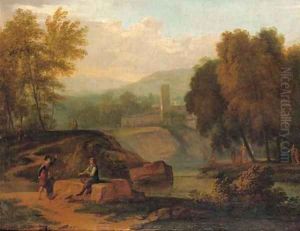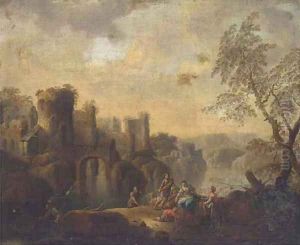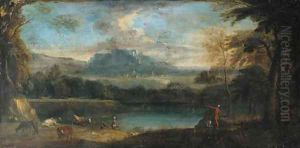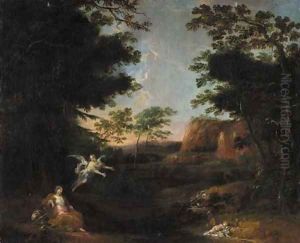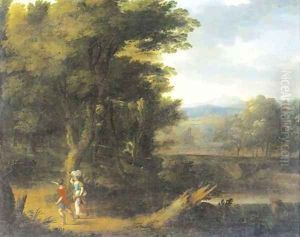Jan Frans Van Bloemen, Called Il Orrizonte Paintings
Jan Frans van Bloemen, known as Orizzonte or Il Orrizonte, was a Flemish landscape painter active during the late 17th and early 18th centuries. Born in Antwerp in 1662, he belonged to a family of artists; his brothers Pieter van Bloemen and Norbert van Bloemen were also painters. Jan Frans was particularly known for his ability to capture the serene beauty of the Roman countryside, which earned him the nickname 'Orizzonte' (Italian for 'horizon') among his Italian contemporaries.
Van Bloemen received his initial artistic training likely within the family from his older brother Pieter, who was well-traveled and had a significant influence on Jan Frans's development as an artist. Seeking broader opportunities and following the footsteps of many Northern European artists of the time, van Bloemen moved to Rome around 1689. There, he became associated with the Bentvueghels, a society of mostly Dutch and Flemish artists working in Rome, and was given the nickname 'Orizzonte' due to his mastery in painting expansive landscapes.
In Rome, van Bloemen's work was greatly admired, and he became known for his poetic interpretation of the Roman Campagna, blending realism with a sense of idealized beauty. He captured the subtle variations of light and atmosphere, imbuing his landscapes with a lyrical quality that resonated with the classical landscape tradition. His paintings often featured ancient ruins, which were a popular subject among Grand Tour travelers and art collectors during the 18th century. He also painted figurative scenes and collaborated with other artists by adding landscape backgrounds to their compositions.
Jan Frans van Bloemen's style was influenced by the work of classical landscape painters such as Claude Lorrain and Gaspard Dughet, whose Arcadian visions were celebrated for their idyllic and harmonious depictions of nature. Van Bloemen adapted these influences to create his own distinctive style, characterized by a gentle palette, skillful handling of light, and balanced compositions. His landscapes had a significant impact on the development of Italian landscape painting and also influenced other Northern European artists who came to Italy.
He spent the majority of his life in Italy and enjoyed considerable success during his lifetime. Despite his Flemish origins, van Bloemen was thoroughly integrated into the Roman artistic community and was even admitted to the prestigious Accademia di San Luca. Jan Frans van Bloemen continued to paint until his death in Rome in 1749. His work remains a testament to the enduring appeal of the classical landscape and the artistic exchange between the Northern European and Italian traditions.
